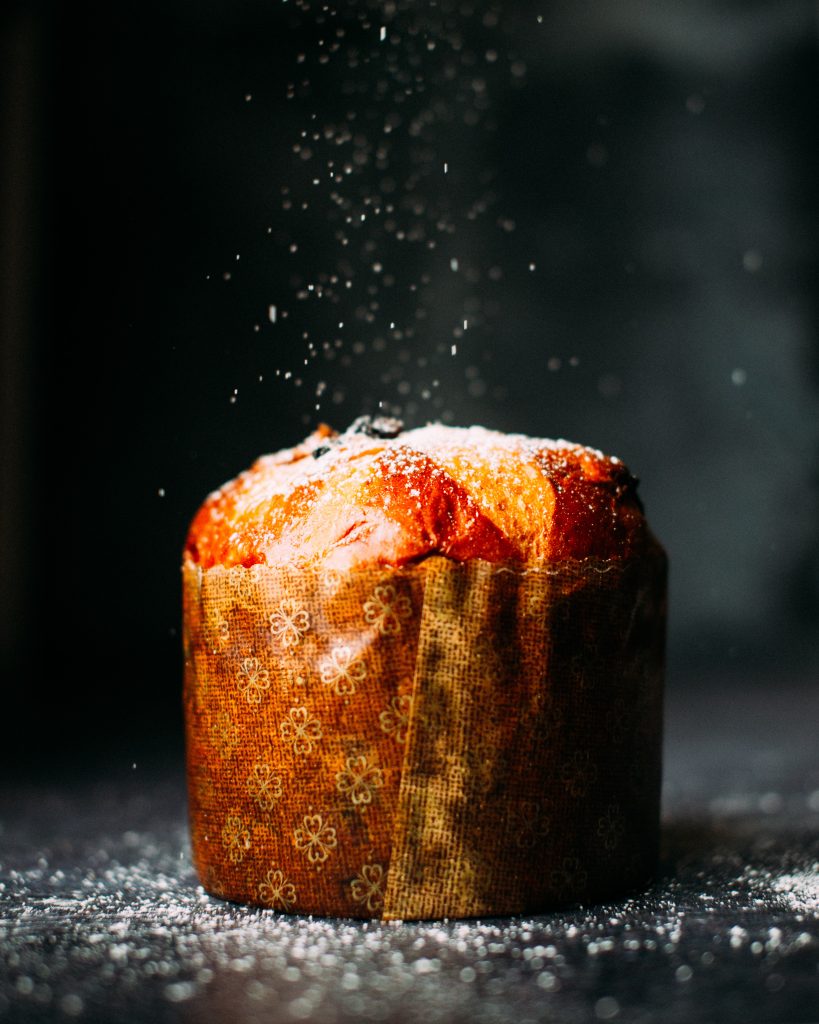Lealisti del panettone e del pandoro che ogni Natale manifestano le loro preferenze. Quest’anno alla discussione, grazie ad una pubblicità, si è aggiunto anche l’elemento veganesimo con l’uso di ingredienti tradizionali oppure no. A prescindere dalle discussioni di rito su ogni cosa, la legge definisce chiaramente queste due tipologie di prodotti da forno con il Decreto del Ministero delle Attività Produttive del 22 luglio 2005.
Il panettone e il pandoro sono sicuramente due dei dolci della tradizione italiana più conosciuti al mondo.
La storia del panettone inizia già nel IX secolo nelle feste cristiane del territorio milanese dove, attorno al focolare, si spezzava un “pane grande” e tutti i commensali ne ricevevano un pezzo in segno di comunione.
Non me ne vogliano gli amanti del primo ma le origini del pandoro sono da ricercare invece addirittura nell’antica Roma. Plinio il Vecchio parla già di un “panis” preparato con fiori di farina, burro e olio. La ricetta attuale pare però derivi dal “pane de oro” dei nobili veneziani del XIII secolo.
Quella del pandoro e del panettone è dunque una tradizione storica che non ha mai abbandonato le tavole degli italiani.
Con natali così antichi e nobili era impossibile che la normativa non li tutelasse
Panettone and Pandoro loyalists who show their preferences every Christmas. This year, thanks to an advertisement, the vegan element has also been added to the discussion with the use of traditional ingredients or not. Regardless of the ritual discussions on everything, the law clearly defines these two types of bakery products with the Decree of the Ministry of Productive Activities of 22 July 2005.
Panettone and pandoro are certainly two of the most popular traditional Italian desserts in the world.
The history of panettone begins as early as the ninth century in the Christian feasts of the Milanese area where, around the hearth, a “big bread” was broken and all the diners received a piece of it as a sign of communion.
I do not want the lovers of the first but the origins of the pandoro are to be found instead even in ancient Rome. Pliny the Elder already speaks of a “panis” prepared with flour, butter and oil flowers. The current recipe, however, seems to derive from the “pane de oro” of the Venetian nobles of the thirteenth century.
That of pandoro and panettone is therefore a historical tradition that has never abandoned the tables of Italians.
With such ancient and noble origins it was impossible that the legislation did not protect them.

La disciplina del Decreto del Ministero 22 luglio 2005 tutela infatti panettone, pandoro colomba, savoiardo, amaretto morbido, nel rispetto della ricetta tradizionale. Ha disciplinato il sistema produttivo allo scopo di contribuire alla definizione dell’identità del prodotto:
- Per ogni prodotto tutelato sono indicati gli ingredienti obbligatori e facoltativi e il procedimento di produzione.
- Cosa sarebbe un panettone senza uvetta e canditi? La legge comunque permette l’uso del nome anche per prodotti privi di alcuni ingredienti e/o arricchiti di altri, purché venga rispettato il diritto all’informazione del consumatore con l’indicazione in etichetta della variazione. Un esempio con il panettone potrebbe essere proprio la questione della presenza o assenza di uvetta e canditi ( “panettone senza uvetta”).
- Ulteriori ingredienti che vadano a caratterizzare il prodotto (come creme, cioccolata, ecc), usati in aggiunta a quelli previsti devono essere dichiarati nella denominazione di vendita, indicandone inoltre la relativa percentuale d’impiego.
- La legge è molto precisa anche sui diminutivi che possono essere utilizzati come denominazione di vendita e così Panettoni e Pandori di piccole dimensioni possono essere denominati “Panettoncini” e “Pandorini”.
- La cosa importante per la piena tutela di questi prodotti è che le regole di produzione e commercializzazione sono identiche sia che si parli di prodotti industriali che di quelli che escono da piccoli laboratori artigianali.
- I prodotti che non corrispondano a quanto indicato dalla legge non possono essere denominati panettone o pandoro e devono quindi usare obbligatoriamente nomi di fantasia che non richiamino i famosi dolci, anche se magari dal punto di vista degli ingredienti risultano molto simili. Ecco spiegato il fiorire di “Stelle di Natale”, “Dolci delle Feste” e altre denominazioni in cui sembrano sbizzarrirsi ogni anno le aziende.
The discipline of the Decree of the Ministry of 22 July 2005 protects in fact panettone, pandoro colomba, savoyard, soft amaretto, in compliance with the traditional recipe. It regulated the production system in order to contribute to the definition of the product identity:
For each protected product, the mandatory and optional ingredients and the production process are indicated.
What would a panettone be without raisins and candied fruit? However, the law allows the use of the name also for products without some ingredients and / or enriched with others, as long as the consumer’s right to information is respected with the indication of the variation on the label. An example with panettone could be the question of the presence or absence of raisins and candied fruit (“panettone without raisins”).
Additional ingredients that characterize the product (such as creams, chocolate, etc.), used in addition to those provided must be declared in the sales denomination, also indicating the relative percentage of use.
The law is also very precise on the diminutives that can be used as a sales denomination and thus small Panettoni and Pandori can be called “Panettoncini” and “Pandorini”.
The important thing for the full protection of these products is that the production and marketing rules are identical whether we are talking about industrial products or those that come out of small artisan workshops.
Products that do not correspond to what is indicated by the law cannot be called panettone or pandoro and must therefore necessarily use fantasy names that do not recall the famous desserts, even if perhaps from the point of view of the ingredients they are very similar. This explains the flourishing of “Poinsettias”, “Dolci delle Feste” and other denominations in which companies seem to indulge themselves every year.

PANETTONE
La denominazione «Panettone» è riservata al prodotto dolciario da forno a pasta morbida, ottenuto per fermentazione naturale a pasta acida, di forma a base rotonda con crosta superiore screpolata e tagliata in modo caratteristico, di struttura soffi ce ad alveolatura allungata e aroma tipico di lievitazione a pasta acida.
Gli ingredienti obbligatori sono: farina di frumento; zucchero; uova di gallina di categoria “A” (cioè uova fresche) o tuorlo d’uovo, o entrambi, in quantità tali da garantire non meno del 4% in tuorlo; materia grassa butirrica (cioè burro), in quantità non inferiore al 16%; uvetta e scorze di agrumi canditi, in quantità non inferiore al 20%; lievito naturale costituito da pasta acida; sale
PANETTONE
The name “Panettone” is reserved for the soft pastry baked confectionery product, obtained by natural fermentation with sour dough, with a round base with a cracked and characteristic cut upper crust, with a soft structure with elongated alveolation and a typical aroma of sourdough leavening.
The obligatory ingredients are: wheat flour; sugar; category “A” chicken eggs (ie fresh eggs) or egg yolk, or both, in quantities such as to guarantee not less than 4% in yolk; butyric fat (ie butter), in a quantity not less than 16%; raisins and candied citrus peel, in quantities not less than 20%; natural yeast consisting of sourdough; salt

PANDORO
La denominazione «Pandoro» è riservata al prodotto dolciario da forno a pasta morbida, ottenuto per fermentazione naturale da pasta acida, di forma a tronco di cono con sezione a stella ottagonale e con superficie esterna non crostosa, una struttura soffice e setosa ad alveolatura minuta ed uniforme ed aroma caratteristico di burro e vaniglia.
Gli ingredienti obbligatori sono: farina di frumento; zucchero; uova di gallina di categoria “A” (cioè uova fresche) o tuorlo d’uovo, o entrambi, in quantità tali da garantire non meno del 4% in tuorlo; materia grassa butirrica (cioè burro), in quantità non inferiore al 20%; lievito naturale costituito da pasta acida; aromi di vaniglia o vanillina; sale.
PANDORO
The name “Pandoro” is reserved for the soft-paste baked confectionery product, obtained by natural fermentation from sour dough, with a truncated cone shape with an octagonal star section and a non-crusty external surface, a soft and silky structure with minute alveolation and uniform and characteristic aroma of butter and vanilla.
The obligatory ingredients are: wheat flour; sugar; category “A” chicken eggs (ie fresh eggs) or egg yolk, or both, in quantities such as to guarantee not less than 4% in yolk; butyric fat (ie butter), in an amount not less than 20%; natural yeast consisting of sourdough; aromas of vanilla or vanillin; salt.
Sono possibili anche versioni “speciali” dei prodotti cioè con farciture, ripieni, glassature, decorazioni e frutta, comunque questi dovranno contenere almeno il 50% dell’impasto base come definito dalla legge.
In tal caso, oltre alle indicazioni di etichettatura specificate dalla normativa, devono figurare in etichetta, accanto alla denominazione riservata, tutte le variazioni sul tema, così che il consumatore possa capire a quale tipo di prodotto si trovi di fronte e quali caratteristiche abbia.
Esempi:
• “ Panettone senza canditi, ricoperto di cioccolato con farcitura alla crema e nocciola”
• “ Pandoro con gocce di cioccolato farcito alla crema”
Aspetto infine importantissimo e necessario soprattutto per la tutela della salute del consumatore è l’etichettatura degli allergeni: tutti i possibili allergeni nel prodotto devono essere riportati nell’etichetta del prodotto in modo evidente rispetto agli altri ingredienti (caratteri in grassetto, colore, sottolineature ecc.).
I prodotti venduti direttamente nei laboratori (quindi preincartati) possono essere commercializzati senza etichetta, purché sul banco di vendita sia presente un cartello che indichi la denominazione di vendita e la lista degli ingredienti e degli allergeni. Tali indicazioni possono essere legittimamente fornite anche attraverso un registro dei singoli prodotti esposto nel punto vendita e disponibile alla consultazione da parte dei clienti.
“Special” versions of the products are also possible, that is with fillings, fillings, glazes, decorations and fruit, however these must contain at least 50% of the base dough as defined by law.
In this case, in addition to the labeling indications specified by the legislation, all the variations on the subject must appear on the label, next to the reserved name, so that the consumer can understand what type of product he is facing and what characteristics it has.
Examples:
• “Panettone without candied fruit, covered with chocolate with cream and hazelnut filling”
• “Pandoro with chocolate drops filled with cream”
Finally, an extremely important and necessary aspect, above all for the protection of consumer health, is the labeling of allergens: all possible allergens in the product must be clearly indicated on the product label compared to the other ingredients (bold characters, color, underlining, etc. .).
The products sold directly in the laboratories (therefore pre-wrapped) can be marketed without a label, as long as there is a sign on the sales counter indicating the sales name and the list of ingredients and allergens. Such information can also legitimately be provided through a register of individual products displayed in the store and available for consultation by customers.
Con il Decreto del 16 maggio 2017 del MiSE che entrerà in vigore dal 12 settembre prossimo viene modificato il D.M. 22 luglio 2005 in esame nell’articolo. Le modifiche riguardano tutti i prodotti dolciari da forno citati dal decreto ministeriale (panettone, pandoro, colomba, savoiardo e amaretto), qui prendiamo in esame quelle relative ai soli panettone e pandoro:
- Panettone: è precisato che, nell’impasto, sono utilizzabili solo uova di gallina di categoria A o tuorlo d’uovo derivato da uova di gallina di categoria A (precisazione, quest’ultima, assente nel precedente testo della norma), o entrambi, e burro ottenuto direttamente ed esclusivamente dalle creme di latte vaccino, con un apporto in materia grassa butirrica in quantità non inferiore al 16%. È inoltre ammesso l’utilizzo del sale iodato in luogo di quello comune.
- Pandoro (e Colomba): analoghe precisazioni concernenti l’impiego di uova di gallina – o tuorlo d’uovo derivato da uova di gallina – di categoria A, burro ottenuto direttamente ed esclusivamente dalle creme di latte vaccino e possibile sostituzione del sale comune con quello iodato sono previste in riferimento all’impasto di pandoro e colomba.
- Ferme restando le suddette denominazioni riservate, i corrispondenti prodotti di piccole dimensioni possono recare le denominazioni “pandorino”, “panettoncino”, “colombina” o similari.
- Prodotti senza glutine: è inserito un inedito art. 8-bis, recante deroghe per i prodotti specificamente formulati per persone intolleranti al glutine, per i quali è confermata la possibilità di riportare le denominazioni “panettone”, “pandoro”, “colomba” e “savoiardo”, purché in linea con quanto stabilito dal regolamento di esecuzione (UE) 828/2014. È precisato che per la sostituzione degli ingredienti apportatori di glutine nei prodotti in esame è consentito esclusivamente l’impiego di ingredienti tecnologicamente necessari a tale scopo.
- Oltre ad apportare modifiche agli allegati tecnici relativi al “calcolo delle percentuali” ed ai “processi tecnologici”, tutti i riferimenti presenti nel testo della norma al superato decreto legislativo 109/92 sono sostituiti da quelli al regolamento (UE) 1169/2011.
With the Decree of May 16, 2017 of the MiSE which will come into force from next September 12, the D.M. July 22, 2005 under review in the article. The changes concern all the baked confectionery products mentioned by the ministerial decree (panettone, pandoro, colomba, savoiardo and amaretto), here we examine those relating only to panettone and pandoro:
Panettone: it is specified that, in the dough, only category A chicken eggs or egg yolk derived from category A chicken eggs can be used (clarification, the latter, absent in the previous text of the standard), or both, and butter obtained directly and exclusively from cow’s milk creams, with a contribution of butyric fat in quantities not less than 16%. The use of iodized salt in place of the common one is also allowed.
Pandoro (and Colomba): similar clarifications concerning the use of chicken eggs – or egg yolk derived from chicken eggs – of category A, butter obtained directly and exclusively from cow’s milk creams and possible substitution of common salt with that iodized are provided with reference to the mixture of pandoro and colomba.
Without prejudice to the aforementioned names reserved, the corresponding small products may bear the names “pandorino”, “panettoncino”, “colombina” or similar.
Gluten-free products: an unpublished art. 8-bis, containing exceptions for products specifically formulated for people intolerant to gluten, for which the possibility of reporting the names “panettone”, “pandoro”, “colomba” and “savoiardo” is confirmed, provided that they are in line with what has been established by the Implementing Regulation (EU) 828/2014. It is specified that for the replacement of gluten-bearing ingredients in the products in question, only the use of ingredients technologically necessary for this purpose is allowed.
In addition to making changes to the technical annexes relating to the “calculation of percentages” and “technological processes”, all references in the text of the standard to the outdated legislative decree 109/92 are replaced by those to regulation (EU) 1169/2011.


